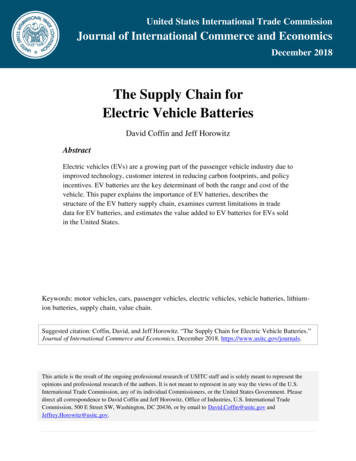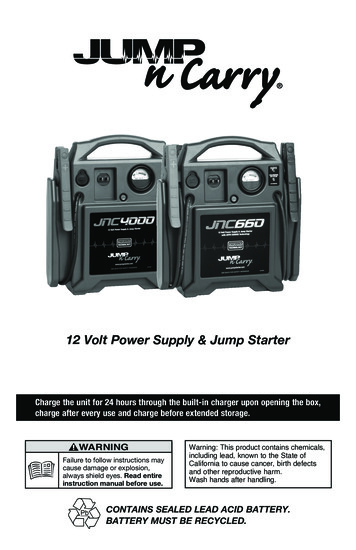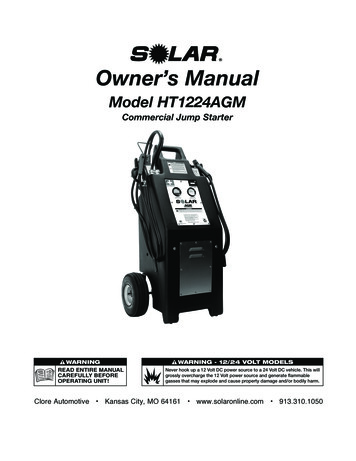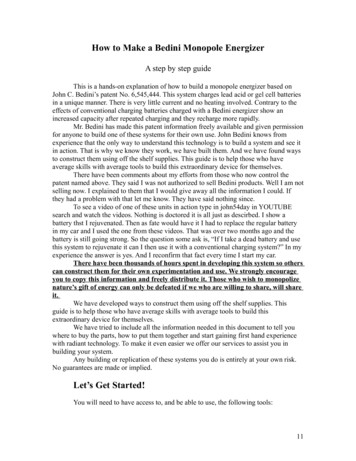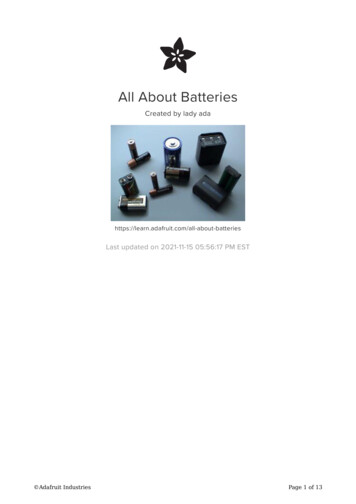
Transcription
All About BatteriesCreated by lady ast updated on 2021-11-15 05:56:17 PM EST Adafruit IndustriesPage 1 of 13
Table of ContentsOverview3How Batteries Are Measured3Power Capacity and Power Capability4Lead Acid Batteries5Alkaline6Ni-Cad Batteries (Nickel Cadmium)8Ni-MH Batteries (Nickel Metal Hydride)9Li-Ion (Lithium-Ion) and LiPoly (Lithium Polymer)10 For An Entire Guide Featuring this subject, check out "Li-Ion & LiPoly Batteries" in the Adafruit Learning System10Lithium Batteries & Coin CellsHow to Pick the Right Battery For Your Project Adafruit Industries1112Page 2 of 13
OverviewThis tutorial is about batteries (if you couldn't tell) - and how to decide which batterieswill run your project best! I'll cover both rechargeable and "one shot" batteries, tryingto cover everything I've learned about these surprisingly-complex electroniccomponents!How Batteries Are MeasuredThere are a few different ways to 'measure' batteries, here are the ones I will becomparing SizeThis is pretty straight forward, how big are the batteries? Lead acid batteriesdon't get much smaller than C-cell batteries. Coin cells don't get much largerthan a quarter. There are also standard sizes, such as AA and 9V which may bedesirable. Weight and power densityThis is a performance issue: higher quality (and more expensive) batteries willhave a higher power density. If weight is an important part of your project, youwill want to go with a lighter, high-density battery. Often this is expressed inWatts-hours per Kilogram. PricePrice is pretty much proportional to power-density (you pay more for higherdensity) and proportional to power capacity (you pay more for more capacity).The more power you want in a smaller, lighter package the more you will have topay. VoltageThe voltage of a battery cell is determined by the chemistry used inside. Forexample, all Alkaline cells are 1.5V, all lead-acid's are 2V, and lithiums are 3V.Batteries can be made of multiple cells, so for example, you'll rarely see a 2V Adafruit IndustriesPage 3 of 13
lead-acid battery. Usually they are connected together inside to make a 6V, 12Vor 24V battery. Likewise, most electronics use multiple alkalines to generate thevoltage they need to run.Don't forget that voltage is a 'nominal' measurement, a "1.5V" AA battery actuallystarts out at 1.6V and then quickly drops down to 1.5 and then slowly drifts downto 1.0V at which point the battery is considered 'dead'. Re-usabilitySome batteries are rechargable, usually they can be recharged 100's of times.Power Capacity and Power CapabilitySince this is a particularly confusing part of measuring batteries, I'm going to discussit more in detail.Power capacity is how much energy is stored in the battery. This power is oftenexpressed in Watt-hours (the symbol Wh). A Watt-hour is the voltage (V) that thebattery provides multiplied by how much current (Amps) the battery can provide forsome amount of time (generally in hours). Voltage * Amps * hours Wh. Since voltageis pretty much fixed for a battery type due to its internal chemistry (alkaline, lithium,lead acid, etc), often only the Amps*hour measurement is printed on the side,expressed in Ah or mAh (1000mAh 1Ah). To get Wh, multiply the Ah by the nominalvoltage. For example, lets say we have a 3V nominal battery with 1Amp-hour capacity,therefore it has 3 Wh of capacity. 1 Ah means that in theory we can draw 1 Amp ofcurrent for one hour, or 0.1A for 10 hours, or 0.01A (also known as 10 mA) for 100hours.However, the amount of current we can really draw (the power capability) from abattery is often limited. For example, a coin cell that is rated for 1 Ah can't actuallyprovide 1 Amp of current for an hour, in fact it cant even provide 0.1 Amp withoutoverextending itself. Its like saying a human has the capability to travel up to 30 miles:of course running 30 miles is a lot different than walking! Likewise, a 1Ah coin cell hasno problem providing a 1mA for 1000 hours but if you try to draw 100mA from it, it'lllast a lot less than 10 hours.For example, in this image, a coin cell can drive a 3.9Kohm resistor and provide230mAh (which is what its rated for) before dropping to 2V, but if its a 1Kohm resistor,it will only provide 125mAh (image from http://biz.maxell.com/en/product primary/?pci 9&pn pb0002 (https://adafru.it/aYC)) Adafruit IndustriesPage 4 of 13
The way the power capability is measured is in C's. A C is the Amp-hour capacitydivided by 1 hour. So the C of a 2Ah battery is 2A. The amount of current a battery'likes' to have drawn from it is measured in C. The higher the C the more current youcan draw from the battery without exhausting it prematurely. Lead acid batteries canhave very high C values (10C or higher) , and lithium coin cells have very low ones(0.01C)Lead Acid BatteriesLead Acid batteries (image above (https://adafru.it/aYD)) are the workhorse batteriesof industry. They are incredibly cheap, rechargeable, and easily available. Lead acidbatteries are used in machinery, UPS's (uninterruptable power supply), robotics, andother systems where a lot of power is needed and weight is not as important. Leadacid batteries come in 2V cells, that means you can have a battery with an evennumber of volts. The most common voltages are 2V, 6V, 12V and 24V. Adafruit IndustriesPage 5 of 13
Pros: Cheap, powerful, easily rechargeable, high power output capability.Cons: Very heavy, batteries tend to be very large bricks because power density isvery low.Prices: A 12V lead acid battery with 7Ah of charge should run about 25.Power Density: 7 Wh/kg.AlkalineAlkaline batteries are the most common batteries you will come across. They are theones sold in every store, so they're great for projects that need to be 'userserviceable.' They have higher power density than NiCads and slightly better powerdensity than NiMH. However, they are one-time use. Cells are 1.5V, and available insizes from coin cells to AAAA to D cell. One nice thing about having multiple sizeswith a standard voltage is that you can always just specify the next size up when youneed more capacity and capability. You'll get the published capacity rate if they aredischarged at about 0.1C. Adafruit IndustriesPage 6 of 13
6V lantern batteries (image above) are very large alkalines made of a couple largecells, they're rather convenient in that they're available in many stores, have massivecapacity and capability and you can clip/solder onto their tabs pretty easily.components 800px-Geöffnete 9V Blockbatterie wide.jpg9V batteries are a strange case: they're actually made of 6 very small 1.5V batteries,pretty much the size of coin cells. As a result they have very low capacity andcapability and are very expensive. If you are drawing more than 20mA then they areprobably not a good idea to use.Prices: AA size battery costs about 1 and has up to 3000 mAh of charge capacity.Power density: 100 Wh/kgPros: Popular, well known, safe, long shelf lifeCons: Non-rechargeable, low-capability Adafruit IndustriesPage 7 of 13
Ni-Cad Batteries (Nickel Cadmium)These are the older rechargeables that were popular for a long time. They come in'standard small' battery sizes like AA, AAA, C as well as rectangular shapes that makethem easier to embed in an enclosure (see image above (https://adafru.it/aYE)). Theyare not used as much these days because NiMH batteries have much higher powerdensity. However, they are cheaper and are still used in many cordless phones, solarlights and RC cars where performance is not as important as price. Another nice thingis they discharge slower than NiMHs. (That is, left alone, they will retain their chargelonger.) Battery cells are 1.2V, often bundled in "packs" of 3 to make 3.6V.Pros: Inexpensive, rugged, come in "standard" sizes, easy to recharge.Cons: Lower power density, requires "full discharge/recharge" cycles every once in awhile to reduce 'memory effect' (the growth of crystals on the battery plates), containstoxic metal.Prices: AA size battery costs around 1 and has up to 1000mAh of charge capacity.Power Density: 60 Wh/kg Adafruit IndustriesPage 8 of 13
Ni-MH Batteries (Nickel Metal Hydride)These are more popular rechargables, they also come in 'standard' sizes. These are agood replacement for standard alkaline batteries in many cases. The battery celvoltage is 1.25V per cell, that's less than the 1.5V of alkalines but more than the 1.2Vof NiCads. The most annoying thing about them is their high self-discharge althoughbattery technology has improved and there are a few low-self-discharge batteries onthe market. They like to be charged at about 0.1C but can be discharged at 0.2CPros: Good alternative to Alkalines in most situations, high power density, "standard"size, better capability than alkalines, pretty easy to recharge but not as rugged.Cons: More expensive than Ni-Cads, service life isn't as long, self-discharges quickly.Prices: AA size battery costs around 2 and has up to 2500mAh of charge capacity.Power Density: 100 Wh/kg Adafruit IndustriesPage 9 of 13
Li-Ion (Lithium-Ion) and LiPoly (LithiumPolymer)For An Entire Guide Featuring this subject, check out "LiIon & LiPoly Batteries" in the Adafruit Learning System (https://adafru.it/aN9)These are the latest in rechargable battery technology, and are quickly becoming themost common batteries for consumer electronics like camcorders, cell phones,laptops etc. They are very lightweight, don't mind high discharge rates, and have veryhigh power density. However, they are very delicate and require special circuitry tokeep them from exploding! This means that raw LiIon cells are very rare and verydangerous. Most li-ion batteries come with protection circuitry that keeps the batteryoperating safely. If you want to use LiIons, your best bet is to use camcorder or cellphone batteries and use the charger that matches up with it. LiIon cels are around3.6V so 3.6V and 7.2V are the most common battery voltages you'll see. They caneasily provide up to 1C of current, some can go up to 10C!Pros: Ultra-light, high power, high capability, high cell voltage.Cons: Expensive, delicate, can explode if misused!Prices: replacement "cell phone" batteries cost around 10 and have 750mAh chargecapacity.Power Density: 126 Wh/kg for lithium ion, 185 Wh/kg for lithium polymer Adafruit IndustriesPage 10 of 13
Lithium Batteries & Coin CellsMost of the lithium batteries you'll see are in coin/button cell form. Coin cells are smalldiscs (see above (https://adafru.it/aYF)), often Lithium cells are used (3V) but Alkaline,zinc air, and manganese are also used (1.5V).They are very small and very light, great for small, low-power devices. They're alsofairly safe, have a long shelf life and fairly inexpensive per unit. However, they are notrechargeable and have high internal resistance (which is what makes them fairly safeif there's only one or two in use) so they can't provide a lot of continuous current:0.005C is about as high as you can go before the capacity is seriously degraded.However, they can provide higher current as long as its 'pulsed' (usually about 10%rate).One of the most popular coin cells in use right now is the CR2032 which is 20mmdiameter x 3.2mm thick, provides 220mAh at 3V. Lithium coin cells can get as large asthe CR2477 (24mm x 8mm) with a capacity of 1000mAh for 3.50The only other lithium cell you'll see around is the CR123, which is a 3V cell thats a bitthicker than a AA battery and a bit shorter too. Adafruit IndustriesPage 11 of 13
Pros: Light, high-density, small, inexpensive, high cell voltage, easy to stack for highervoltages, long shelf-life.Cons: Non-reusable, low current draw capability, needs a special holder.Prices: CR2032 are around 0.35 (220mAh) CR123's are 1.50 (1300Ah).Power density: 270 Wh/kgHow to Pick the Right Battery For YourProjectOK, so you have a project and now you want to power it off of a battery, how do youchoose the best setup?The two easiest cases are the extremes: Is your project very power-hungry? Projectors, large sound systems, andmotorized projects all draw on the order of amps of current! You'll want to gowith lantern cells (one-time use) or lead acid batteries (rechargable). If you areplanning to be somewhat 'abusive' to the battery (heavy-usage, running it downall the way) you may want to look at "marine deep cycle" batteries. Is your project super-small, like an inch on each side? You're going to have to gowith a lithium coin cell (one time use) or little lithium-polymer cells like the onesused for tiny RC planes.Here are some other very popular cases: Do you need to make a lot of these things? Go with inexpensive alkalinebatteries in popular sizes. Need to be user-servicable? 9V or AA size batteries are universal! 5V input necessary? 3 Alkaline (4.5V) or 4 NiMH cells (4.8V) will get you prettyclose - check your circuit to see if it'll run at these slightly lower voltages Making a 'rechargeable battery pack'? Use a battery holder from your localhobby/electronics/repair shop and stick with NiMH batteries, then rechargethem with a high quality charger. Want to replace alkalines with rechargeables? Test to make sure that the lowervoltage won't make the device unhappy. Adafruit IndustriesPage 12 of 13
Need to stack batteries? Remember to stack batteries only if they have matchingC and Ah capability, if you stack a 9V and a AA to make 10.5V the 9V will drainin 1/10th the time leaving you with 1.5V. Want your rechargable batteries to last a long time? Use a high-quality chargerthat has sensors to maintain proper charging and trickle charging. A cheapcharger will kill off your cells. Adafruit IndustriesPage 13 of 13
Nov 15, 2021 · This is pretty straight forward, how big are the batteries? Lead acid batteries don't get much smaller than C-cell batteries. Coin cells don't get much larger than a quarter. There are also standard sizes, such as AA and 9V which may be desirable. Weight and power density This is a

